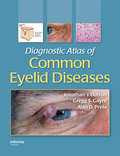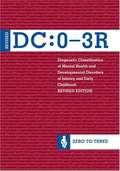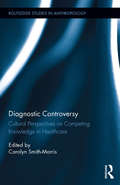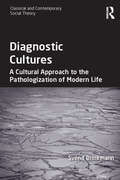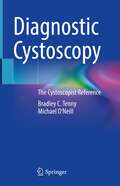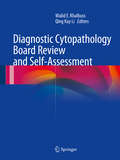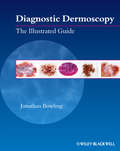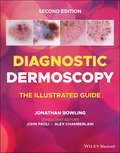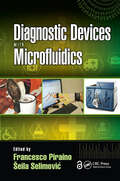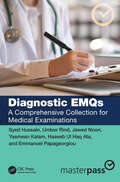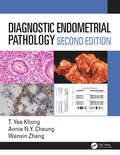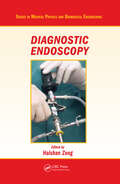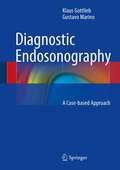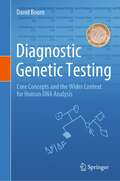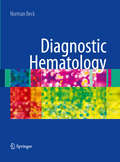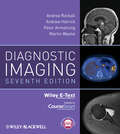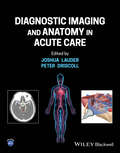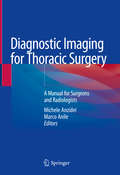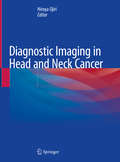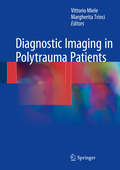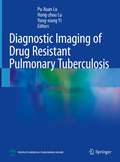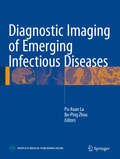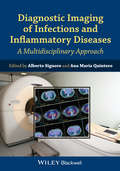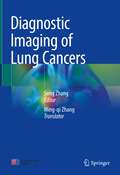- Table View
- List View
Diagnostic Atlas of Common Eyelid Diseases
by Jonathan J. Dutton Gregg S. Gayre Alan D. ProiaUnlike any other source on the subject, this broad-ranging guide discusses the pathology, diagnosis, and treatment of 120 eyelid disorders including benign lesions, malignant tumors, and acquired and congenital malpositions and diseases. Written by leading researchers practiced in the analysis and management of these conditions, this source is a mu
Diagnostic Classification of Mental Health and Developmental Disorders of Infancy and Early Childhood (Revised)
by Zero To Three StaffZERO TO THREE'S Diagnostic Classification of Mental Health and Developmental Disorders of Infancy and Early Childhood (DC:0-3), published in 1994, was designed to address the need for a systematic, developmentally based approach to the classification of mental health and developmental difficulties in the first 4 years of life.
Diagnostic Controversy: Cultural Perspectives on Competing Knowledge in Healthcare (Routledge Studies in Anthropology #25)
by Carolyn Smith-MorrisThis collection is dedicated to the diagnostic moment and its unrivaled influence on encompassment and exclusion in health care. Diagnosis is seen as both an expression and a vehicle of biomedical hegemony, yet it is also a necessary and speculative tool for the identification of and response to suffering in any healing system. Social scientific studies of medicalization and the production of medical knowledge have revealed tremendous controversy within, and factitiousness at the outer parameters of, diagnosable conditions. Yet the ethnographically rich and theoretically complex history of such studies has not yet congealed into a coherent structural critique of the process and broader implications of diagnosis. This volume meets that challenge, directing attention to three distinctive realms of diagnostic conflict: in the role of diagnosis to grant access to care, in processes of medicalization and resistance, and in the transforming and transformative position of diagnosis for 21st-century global health. Smith-Morris’s framework repositions diagnosis as central to critical global health inquiry. The collected authors question specific diagnoses (e.g., Lyme disease, Parkinson's, andropause, psychosis) as well as the structural and epistemological factors behind a disease’s naming and experience.
Diagnostic Cultures: A Cultural Approach to the Pathologization of Modern Life (Classical and Contemporary Social Theory)
by Svend BrinkmannSome studies estimate that each year, around a quarter of the population of Western countries will suffer from at least one mental disorder. Should this be interpreted as evidence for the progress of psychiatry, a discipline that is now able to identify and treat mental illnesses that have always existed, or might it be the case that modern life somehow creates new conditions, or social pathologies? This book argues that in fact something more fundamental has been taking place in recent years: the development of diagnostic cultures. Taking account of the phenomenon of patients themselves 'pushing for' pathologization - and acknowledging therefore that this is not simply a case of psychiatry pursuing an agenda of 'medicalisation from above' - this volume examines the emerging trend towards interpreting our sufferings in terms of psychiatric conceptions and diagnostic categories. Drawing on new empirical case studies of psychological diagnoses, including depression and ADHD, and employing both cultural-psychological and sociological analyses, it charts the development of contemporary diagnostic cultures and asks whether, in transforming existential, moral and political concerns into individual psychiatric disorders, we risk losing sight of the larger historical and social forces that affect our lives. A ground-breaking examination of the shift towards the pathologization of suffering and the dangers that this presents to human self-understanding, Diagnostic Cultures will be of interest to scholars of social theory and philosophy, the sociology of culture, psychology and the sociology health and medicine.
Diagnostic Cystoscopy: The Cystoscopist Reference
by Michael O'Neill Bradley C. TennyDiagnostic cystoscopy is the gold standard procedure in assessing anatomical variations and/or bladder pathologies. For example, for a clinician to adequately rule out carcinoma in situ of the bladder the clinician must directly visualize the whole bladder. Mastering this skill is thus incredibly important for the training MD and training advanced practice provider (Nurse Practitioner or Physician Assistant). Once mastered, this readily available reference will serve to benefit said clinician in differentiating benign and malignant pathologies. This text is designed as a comprehensive review by experts in the field of urology on the cystoscope, including both the flexible and rigid instrument, technical use, and certainly bladder pathologies. The rigid cystoscope includes three parts: the scope/lens, bridge, and sheath. These three parts may seem self-explanatory, however there are array of varying options within these three parts that have specific indications for use. Thus, being very familiar with these instruments is vital in being a great cystoscopist. This book will prepare all practitioners to improve and perfect their skills as cystoscopists.Perhaps most significantly, this book will cover numerous topics in normal anatomy, benign and malignant urethral pathology, and benign and malignant bladder pathology. Dialogue on each presented topic includes a brief pathological discussion, associated clinical significance such as common signs or symptoms, suggested treatment for said topic, additional references for further reading, and photographs. Photographs are included on every topic, with a minimum of one image and a maximum of five for reference. A comprehensive reference on diagnostic cystoscopy has been needed for quite some time. This book will satisfy this need for both the developing and experienced cystoscopist.
Diagnostic Cytopathology Board Review and Self-Assessment
by Walid E. Khalbuss Qing Kay LiDiagnostic Cytopathology Board Review and Self-Assessment provides a comprehensive systems-based review of non-gynecological cytology including cytomorphology, pitfalls and ancillary studies, presented in a high-yield format with board-type multiple choice questions and detailed answers. It provides an excellent review, resource and self-assessment for pathologists, cytopathologists and cytotechnologists, as well as trainees (pathology residents, cytopathology fellows and cytotechology students) who are preparing for board examinations or in-service examinations, in addition to those who are looking to fine-tune their cytology diagnostic skills. The volume is organized in a systems-based format including chapters covering lung, lymph nodes, pancreas, liver, gastrointestinal tract, thyroid, salivary gland, central nervous system, soft tissue and bone, kidney, adrenal, retroperitoneal and exfoliative cytology of urine, serous fluids and CSF. This book is enriched with the following features to maximize studying and review of cytopathology" HIGH YIELD REVIEW: Concise high-yield review with tables emphasizing key points, useful criteria and important concepts to maximize your score on board examinations and your diagnostic knowledge of exfoliative and aspiration cytopathology. BOARD EXAM-TYPE QUESTIONS: Over 800 board exam-type questions covering all areas of non-gynecological cytology with emphasis on cytomorphology, diagnostic pitfalls and ancillary studies, including detailed answers with in-depth discussions and key references from the literature and major cytopathology text books. HIGH QUALITY FULL-COLOR IMAGES: Over 600 high-quality full-color photomicrographs, including images of immunohistochemical stains and other ancillary studies performed.
Diagnostic Dermoscopy
by Jonathan BowlingIdeal for clinic use, both for diagnosis and for explaining to the patient, this guide provides:A quick reference atlas guide to the diagnosis skin lesions, especially, but not limited to, those that are cancerous Icons for each condition linked to high definition dermoscopy and clinical photographs Real dermatoscopic images and the associated clinical photographs on the page opposite
Diagnostic Dermoscopy: The Illustrated Guide
by John Paoli Alex ChamberlainDIAGNOSTIC DERMOSCOPY DIAGNOSTIC DERMOSCOPY Diagnostic Dermoscopy delivers a focused, practical and user-friendly guide to diagnosing the most frequently seen presentations of skin lesions practitioners encounter in clinic. The new edition offers a comprehensive collection of strategies to find and diagnose skin cancers at an earlier point in their evolution, and to increase confidence in diagnosing benign lesions to reduce both patient morbidity and mortality. The many full-colour illustrations included within are standardised to aid in recognition, while the adjoining dermoscopy images focus on critical diagnostic features which, when combined with the provided clinical information, are sufficient for specific diagnoses or narrow differential diagnoses. The new edition is formatted to aid teledermoscopy education, including many illustrated cases for reference. Diagnostic Dermoscopy offers: A comprehensive overview of melanocytic lesions, melanoma presentations, and non-melanocytic lesions Thorough explorations of basal cell carcinoma and keratinocyte dysplasia Practical discussions of several special sites, including acral, nail, facial, and scalp lesions, as well as trichoscopy In-depth examinations of vascular lesions, inflammoscopy for general dermatology, and entomodermoscopy Detailed illustrations of genetic and iatrogenic lesions Tips from international experts in melanoma diagnosis Diagnostic Dermoscopy is the ideal resource for dermatologists, primary care physicians, plastic surgeons and allied health practitioners involved in skin lesion and melanoma diagnosis. Dermoscopy UK Further information on dermoscopy education, and online courses can be found at www.dermoscopy.co.uk
Diagnostic Devices with Microfluidics (Devices, Circuits, and Systems)
by Francesco Piraino Šeila SelimovićThis book provides a current view of the research and commercial landscape of diagnostics devices, particularly those that utilize microscale technologies, intended for both patient and laboratory use. Common diagnostic devices that are based on microfluidic principles include glucose sensors for diabetic patients and over-the-counter pregnancy tests. Other diagnostic devices are being developed to quickly test a patient for bacterial and viral infections, and other diseases. The chapters, written by experts from around the world, discuss how to fabricate, apply, and market microfluidic diagnostic chips – for lab and at-home use. Most importantly, the book also contains a discussion of topics relevant to the private sector, including patient-focused, market-oriented development of diagnostics devices. <P><P>Chapter 9 of this book is freely available as a downloadable Open Access PDF under a CC-BY 3.0 license. https://s3-us-west-2.amazonaws.com/tandfbis/rt-files/docs/Open+Access+Chapters/9781498772938_oachapter9.pdf
Diagnostic EMQs: A Comprehensive Collection for Medical Examinations (MasterPass)
by Syed Hussain Umber Rind Jawed Noori Yasmean Kalam Haseeb Ul Ata Emmanuel PapageorgiouAuthored by experienced medical professionals, this essential book equips readers with the skills and knowledge needed to excel in the field of medical diagnosis. It is an extensive collection of Extended Matching Questions (EMQs) covering a wide range of topics in general medicine. Each question is accompanied by detailed explanations to provide comprehensive insights. By engaging with these realistic scenarios, readers will develop a deeper understanding of medical conditions, their presentations, and the appropriate diagnostic approaches. The book goes beyond memorization, fostering analytical skills and honing the ability to identify key diagnostic clues within the questions themselves.
Diagnostic Endometrial Pathology 2E
by Yee Khong Annie NY Cheung Wenxin ZhengEndometrial cancer remains the most frequent gynaecological cancer in first world countries.This bench book on endometrial pathology distils the current literature to provide a practical text on endometrial pathology. Differential diagnosis is emphasised, and the clinical correlates of pathology are also stressed to make this a clinically useful book.Fully updated and including over 400 colour images, this book provides a valuable resource for the practising pathologist in general and community hospitals as well as in teaching hospitals.
Diagnostic Endoscopy (Series in Medical Physics and Biomedical Engineering)
by Haishan ZengCombining a professional development course on diagnostic endoscopy from SPIE (the international society advancing light-based research) and the authors' graduate course on biomedical optics, this work is written for researchers in medical optics and biomedical engineering as well as graduate medical optics students. It uses extensive examples/case
Diagnostic Endosonography
by Klaus Gottlieb Gustavo MarinoThe available textbooks on endoscopic ultrasound (EUS) typically focus on technique and interpretation of commonly observed images and scenarios and are aimed primarily at trainees. However, independent practitioners of EUS are often challenged by unusual cases which they are expected to handle competently despite the absence of authoritative guidance. The Diagnostic Endosonography aims to fill this gap by presenting carefully selected cases that will expand the practitioner's knowledge base and cover important clinical challenges. The case material is organized principally according to anatomic site. Approximately 170 case reports are included, each of which is accompanied by an average of three to five high-quality EUS images; in addition, CT and PET scans are shown when appropriate. For each case, the case description is followed by helpful "teaching points" as well as up-to-date literature references and suggestions for future research.
Diagnostic Flow Cytometry in Cytology
by Pranab DeyThe book covers the essential practical techniques of flow cytometry in detail. It is divided into two sections: The first section includes the basic practical techniques of flow cytometry in cytology samples. Chapters under this section provide detailed description of the sampling technique, processing, acquisition of the sample, instrumentation and basic principles of flow cytometry. The second section elucidates clinical applications of flow cytometry. Chapters cover the flow cytometry applications in various haematolymphoid neoplasms, tumors of solid organs and body fluid samples. The flow cytometry findings of different tumors are described with the help of multiple colored cytology microphotographs, flow cytometry graphs, boxes, and tables. In addition, it also describes other ancillary techniques in those neoplastic lesions. The book helps practicing pathologists, technical staff and post graduate students to understand flow cytometry findings of the haematolymphoid neoplasms and solid tumor with special emphasis on cytology along with advanced technique. This book will help the students to interpret flow cytometry graphs.
Diagnostic Genetic Testing: Core Concepts and the Wider Context for Human DNA Analysis
by David BournOver the last decade, technical advances have allowed genomic testing which provides a great opportunity for diagnosis but also an increased chance of uncertain or unexpected findings. This book addresses many of the questions that arise in this context and summarizes the essential concepts in diagnostic genetic testing in an easy-to-read manner. It also covers some broad context for the practical and ethical implications of examining human DNA sequences. The book starts with a general introduction to the field, providing enough background to allow readers without any previous education in genetics to comprehend the material in the subsequent chapters. The main part explores differing aspects of human genetics and the wider implications of testing in these areas. The author covers not only single gene inheritance, but also genetic testing of cancers and how testing benefits the patients. Special emphasis is also given to the questions of genetics and identity. The concluding part then draws the main themes together and summarises the wider significance of genetics. It also explores the gap between promises made for the impact of advances in genetics, and the actual benefits to patients. The book is written for everyone interested to learn about the process of genetic testing and the broader implications. Moreover, it is aimed at health professionals with an interest in genetics, at students or scientific trainees looking for an introduction to diagnostic genetics, and at professionals in health policy or health journalism.
Diagnostic Hematology
by Norman BeckThe approach described in this book is different from that in most student texts, and has been very successful in practice, starting almost from scratch, but omitting many of the 'basics' such as the details of hematopoiesis, laboratory technology, and so on, which are hardly relevant to the practising clinician and student in the wards, and are primarily of interest to the hematologist and sometimes to the clinical specialist. Considerable emphasis is given to the clinical history and examination, and the interpretation of the clinical patterns thus exposed. Hopefully it will overcome many of the traditional problems experienced in practical diagnostic haematology.
Diagnostic Imaging
by Peter Armstrong Andrew Hatrick Andrea G. Rockall Martin WastieDiagnostic Imaging will help medical students, junior doctors, residents and trainee radiologists understand the principles behind interpreting all forms of imaging. Providing a balanced account of all the imaging modalities available - including plain film, ultrasound, computed tomography, magnetic resonance imaging, radionuclide imaging and interventional radiology - it explains the techniques used and the indications for their use.Organised by body system, it covers all anatomical regions. In each region the authors discuss the most suitable imaging technique and provide guidelines for interpretation, illustrating clinical problems with normal and abnormal images.Diagnostic Imaging is extensively illustrated throughout, featuring high quality full-colour images and more than 600 photographs. The images are downloadable in PowerPoint format from the brand new companion website at www.wileydiagnosticimaging.com, which also has over 100 interactive MCQs, to aid learning and teaching.When you purchase the book you also receive access to the Wiley E-Text: Powered by VitalSource. This is an interactive digital version of the book, featuring downloadable text and images, highlighting and note-taking facilities, bookmarking, cross-referencing, in-text searching, and linking to references and abbreviations. Diagnostic Imaging is also available on CourseSmart, offering extra functionality as well as an immediate way to access the book. For more details, see www.coursesmart.com or 'The Anytime, Anywhere Textbook ' section.
Diagnostic Imaging and Anatomy in Acute Care
by Peter Driscoll Joshua LauderImage-focused introductory text exploring various contemporary radiology modalities including X-ray, CT, Nuclear medicine, MRI, Ultrasound, and Interventional Diagnostic Imaging and Anatomy in Acute Care provides an overview of imaging modalities, focusing on plain radiology, CT, ultrasound and MRI. Nuclear medicine and interventional radiology are also included in cases relevant to acute care. To aid in reader understanding, this book includes a multitude of pictures annotated with clinically relevant anatomy, enabling readers to compare normal anatomy with pathology and cross reference with previous anatomical knowledge. Diagnostic Imaging and Anatomy in Acute Care includes discussion on: How to effectively utilize radiology services when managing acute cases which are commonly present in emergency and urgent care Tips for dealing with time-sensitive situations where immediate reporting is not available Specific terminology pertaining to each different modality and how each modality can be interpreted systematically Methods to identify key abnormalities through effective usage of pattern recognition Diagnostic Imaging and Anatomy in Acute Care is an essential reference on this subject for front line clinicians involved in acute care, specialty doctors who would like to know more about imaging modalities, nurses and allied health professionals with an interest in anatomy and imaging, and students of the above disciplines.
Diagnostic Imaging for Thoracic Surgery: A Manual for Surgeons and Radiologists
by Michele Anzidei Marco AnileThis book offers a comprehensive overview of thoracic pathologies of surgical interest involving the lung, mediastinum, esophagus, and chest wall with the aim of providing both radiologists and thoracic surgeons with a reference of high value in everyday clinical practice. Oncologic and non-oncologic conditions are reviewed from both the radiological and the surgical point of view, each one being documented with the aid of high-quality radiologic images from several modalities (including X-ray, fluoroscopy, CT, MR, and PET), illustrations/artwork, and high-definition images from the surgical table. The postoperative anatomy and complications associated with thoracic surgery procedures are also described in detail, with provision of imaging examples that highlight aspects of importance in differentiating between normal and abnormal findings. Written by experts in the field, Diagnostic Imaging for Thoracic Surgery is exceptional in combining precise descriptions of surgical procedures with key teaching points in imaging interpretation.
Diagnostic Imaging in Head and Neck Cancer
by Hiroya OjiriThis succinct compendium focuses on the key practical aspects of head and neck cancer imaging. It also provides essential information on handling and analyzing imaging data. Head and neck cancer is the sixth most common cancer worldwide. CT and MRI imaging are absolutely crucial to accurate diagnosis and staging, and radiologists have to be especially familiar with the anatomy of that region of the body. In addition, they must be highly proficient in interpreting radiographic images in order to judge the patterns of metastasis, response to treatment, and the signs and patterns of recurrence. This concise but detailed book describes the latest imaging modalities for all types of head and neck cancer diagnosis in light of recent technological advances. Featuring abundant high-quality images supplemented by advice from experts on the management of each cancer, it is a valuable resource for diagnostic and general radiologists, as well as all medical staff involved in the management of head and neck cancers.
Diagnostic Imaging in Polytrauma Patients
by Vittorio Miele Margherita TrinciThis book provides comprehensive information on Diagnostic Imaging for polytrauma patients. It provides extensive and detailed explanations of the semiotics of traumatic injuries, the correlation with the trauma's mechanism of action, and the meaning and appearance of prognostic indicators. The book begins with a discussion of the management of polytrauma patients. Particular attention is given to the role of radiology in management, and each chapter includes an assessment of the radiological findings to be used as a clinical decision-making tool. Several typical cases are shown, supplemented by a wealth of images. The book offers a useful tool both for radiologists, who will find in it a valuable guide to correctly diagnosing traumatic injuries, and for clinicians, who will come to better understand the findings of the diagnostic tests performed on their patients
Diagnostic Imaging of Drug Resistant Pulmonary Tuberculosis
by Pu-Xuan Lu Hong-Zhou Lu Yong-Xiang YiTuberculosis is among the top 10 causes of death worldwide.The WHO clearly proposed that drug-resistant tuberculosis is one of the three major challenge in tuberculosis prevention and control .The book consists of detection of drug-resistant TB and its epidemics, laboratory examination for drug-resistant tubercle bacillus, pathogenic mechanism of drug-resistant TB and its diagnosis, differential diagnosis, treatment, prevention and prognosis of drug-resistant pulmonary TB. This book also focuses on the information of classic cases of drug-resistant TB, including mono-drug-resistant (including Rifampicin resistance, etc.), multidrug-resistant, poly-drug-resistant, extensive-drug-resistant (pre-extensive-drug-resistant), drug-resistant bronchial TB, and pediatric drug-resistant, as well as AIDS complicated with drug-resistant TB, and diagnosis and treatment of drug-resistant cervical TB lymphadenitis. The book also provided a comprehensive description and in-depth analysis for each selected case and a systematic explanation for latest cutting-edge issues, such as dynamic changes in images during the treatment of drug-resistant TB as well as the research and application of artificial intelligence in diagnosing drug-resistant TB, to further inspire our readers. This is a useful book to refer to for respiratory physicians, radiologists, and clinicians in preventive medicine, as well as government officials working in health policies.
Diagnostic Imaging of Emerging Infectious Diseases
by Pu-Xuan Lu Bo-Ping ZhouThis book introduces the diagnosis of Emerging Infectious Diseases (EIDs), including newly emerging infectious diseases and also infectious diseases that show resistance to present treatments. Radiographic examinations are of great value in EIDs diagnosis, differential diagnosis, treatment efficacy assessment and prognosis evaluation. This book covers severe acute respiratory syndrome (SARS), human avian influenza (H5N1, H7N9), influenza A (H1N1), hand-foot-mouth disease, acquired immune deficiency syndrome (AIDS), viral hepatitis, pulmonary tuberculosis. All seven of these EIDs are associated with high incidence and mortality. This book details the imaging techniques, radiological appearance and characteristics of EIDs, and diagnosis and differential diagnosis of EID-related complications. Considering the unique and in some cases only partially understood nature of EIDs, appropriate space is provided in this book for the detailed explanation of the etiology, epidemiology, pathophysiology, clinical symptoms and signs, laboratory tests, clinical diagnosis and differential diagnosis, prevention, treatment, and prognosis of EIDs. As such, it will be a valuable resource for improving the prevention, diagnosis, and treatment of EIDs. Editors Pu-Xuan Lu and Bo-Ping Zhou are professors at Shenzhen Third People's Hospital, Guangdong Medical College, China.
Diagnostic Imaging of Infections and Inflammatory Diseases
by Ana Maria Quintero Alberto SignoreThoroughly and systematically presents the state-of-the-art in the diagnostic uses of radiologic imaging and nuclear medicine in the diagnosis and management of infectious and inflammatory diseasesAlthough our understanding of microorganisms has advanced significantly and antimicrobial therapy has become increasingly available, infection remains a major cause of patient morbidity and mortality. Imaging of infection and inflammation provides a classic example of radiology and nuclear medicine's strengths as well as weaknesses in the discovery and diagnosis of disease. Fortunately, the weaknesses are subsiding as new studies and techniques point to better planning and precision in the use of single and combined imaging modalities.Diagnostic Imaging of Infections and Inflammatory Diseases: A Multidisciplinary Approach deals with the very latest developments in the use of radiologic techniques and modalities in the management of patients with a host of infectious and inflammatory diseases. Tremendously timely and useful, this innovative, multidisciplinary book covers a wide range of topics in three parts:PART 1: Infections and Host Response* Epidemiology of Infections in the New Century* Bacterial Osteomyelitis: the Clinician Point of ViewPART 2: Radiological Imaging* Radiological Imaging of Osteomyelitis* Radiological Imaging of Spine Infection* Radiological Imaging of Soft Tissue Infections* Radiological Imaging of Abdominal Infections and Inflammatory Disease* Radiological Imaging of Vascular Graft Infection* Radiological Imaging of TB and HIVPART 3: Nuclear Medicine Imaging* Nuclear Medicine Imaging of Infections: Techniques, Acquisition Protocols, and Interpretation Criteria* Nuclear Medicine Imaging of Osteomyelitis: WBC, Monoclonal Antibody, or Bacterial Imaging?* Nuclear Medicine Imaging of Spondylodiscitis: The Emerging Role of PET* Nuclear Medicine Imaging of Soft Tissue Infections* Nuclear Medicine Imaging of Infections and Inflammatory Diseases of the Abdomen* Nuclear Medicine Imaging of Vascular Graft Infections: The Added Role of Hybrid Imaging* Nuclear Medicine Imaging of TB and HIV* Nuclear Medicine Imaging of Fever of Unknown Origin* Nuclear Medicine Imaging of Inflammatory DiseasesAlong with carefully developed clinical cases describing the management of patients with inflammation and infection, Diagnostic Imaging of Infections and Inflammatory Diseases is an ideal guide for radiologists and nuclear medicine physicians as well as clinical specialists from many other fields.
Diagnostic Imaging of Lung Cancers
by Song ZhangThis book systematically covers diagnostic imaging of lung cancers, including epithelial tumors, mesenchymal tumors, and hematolymphoid tumors, with emphasis on relationship between classification, molecular pathology, clinical findings, imaging manifestations and pathological discussion. In each chapter, selective cases and wealthy of typical illustrations are presented for helping readers to have an in-depth understanding of key points in differential diagnosis of different types of lung cancers. It will be an ideal reference for physicians involved in the diagnosis and treatment of lung cancers.
